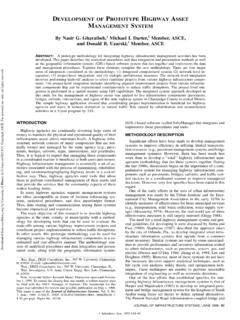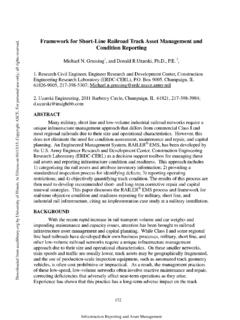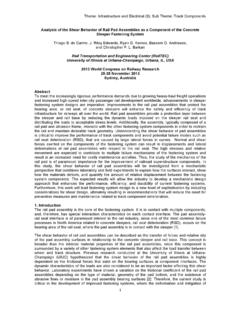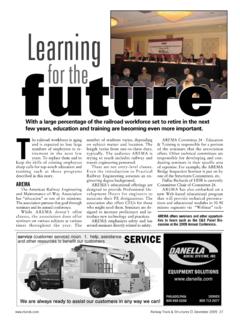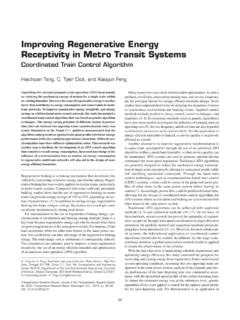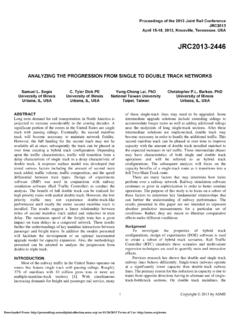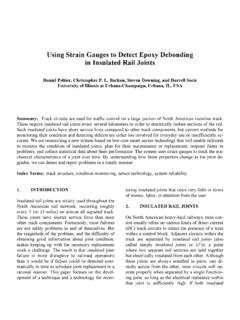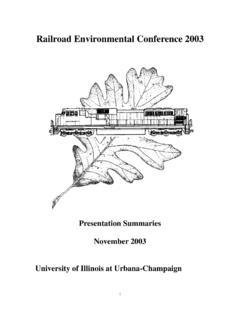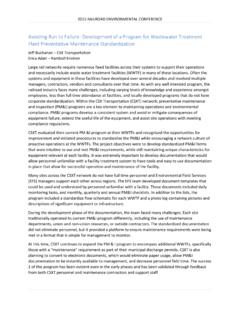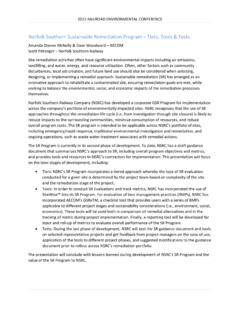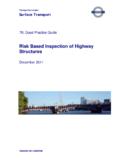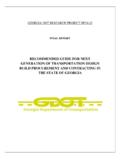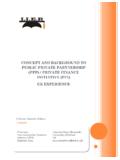Transcription of Quantitative prediction of the risk of heavy haul …
1 Proceedings of the 11th International heavy Haul Association Conference (IHHA 2017),Cape Town, South Africa, 2 6 September 2017 Page 13061 INTRODUCTION highway -rail level crossing safety has been a topic of concern to railroads and the general public since the beginning of railroad construction. From 1991 to 2010, approximately 71,000 collisions occurred at public highway -rail level crossings in the United States ( ), including about 57,000 at publicly-ac-cessible level crossings on mainline railroad tracks (FRA 2011a). Each collision has the potential to cause not only casualties to highway users, but also train passenger and crew casualties, property damage, or the release of dangerous goods. A number of seri-ous level crossing collisions have occurred in recent years, resulting in casualties (NTSB 2015a, b, Asso-ciated Press 2015) and dangerous goods releases (NTSB 2014).
2 Since resources for level crossing improvements are finite, it is important to identify crossings that pose the greatest risk. Researchers and practitioners have devoted significant effort and resources to re-ducing risk to highway users. A variety of methods for modeling collision likelihood at level crossings have been developed, focusing on the risk trains pose to highway vehicles and their occupants, including the Department of Transportation Accident Pre-diction Model (FRA 1987; Ogden & Korve Engineer-ing 2007) that is widely used in the , and a variety of models developed to address limitations of that model (Benekohal & Elzohairy 2001, Austin & Car-son 2002, Saccomanno et al. 2004, Oh et al.)
3 2006, Washington & Oh 2006, Saccomanno et al. 2007). The results of these and other studies have led to im-proved level crossing warning systems, integration of level crossing operations with highway traffic signal-ing, public education programs such as Operation Lifesaver, and numerous other improvements in engi-neering and education (Mok & Savage 2005). These technologies and programs aim to reduce the number of casualties due to train- highway vehicle collisions, and the result has been a steady decline in the number of incidents and casualties over the past several dec-ades. Although the focus on level crossing safety has led to considerable improvements, one aspect has been largely overlooked the risk that highway -rail level crossings pose to trains.
4 Each year, to 1% of level crossing collisions result in a train derailment. Even if a train does not derail, casualties can occur to pas-sengers and crew aboard the train, and damage to the railroad track can result in lost service time and finan-cial impacts. If the train does derail, there is additional potential for casualties among passengers and crew, Quantitative prediction of the risk of heavy haul freight train derailments due to collisions at level crossings Chadwick & C. Barkan University of Illinois at Urbana-Champaign, Illinois, USA Saat Association of American Railroads, Washington, , USA ABSTRACT: The current methodology for prioritizing level crossing (LC) warning system upgrades and elim-ination in the United States ( ) focuses on the likelihood of collisions between highway and rail vehicles as well as highway user fatalities.
5 However, these metrics do not encompass all LC risks . In particular, they do not consider the risk of derailment that LCs pose to trains, crews, and cargo (especially dangerous goods). Little previous research has considered this aspect of LC risk, although its impact is potentially severe. LCs have caused a number of train accidents in the , including several that resulted in dangerous goods releases leading to injuries and fatalities. In this paper, we present a multi-factor statistical model that predicts the like-lihood of a train derailment as a result of various LC parameters. The model was developed based on extensive data from the Department of Transportation s Federal Railroad Administration. It extends and formalizes previous work that identified factors leading to increased derailment likelihood for freight trains in LC collisions such as involvement of heavy highway vehicles ( trucks/lorries) and higher train and motor vehicle speeds.
6 The new model accounts for train and locomotive weight as additional factors to quantify derailment likelihood. The goal is development of a comprehensive understanding of the risk that level crossings pose to railroads and train operations. Proceedings of the 11th International heavy Haul Association Conference (IHHA 2017),Cape Town, South Africa, 2 6 September 2017 Page 1307as well as the risk of a release if the train is carrying dangerous goods. With increased interest in passen-ger rail transportation and the growth in transporta-tion of hazardous materials such as crude oil, the im-portance of comprehensive understanding of the risk of level crossing collisions is more critical than ever. This paper presents a statistical model that enables Quantitative assessment of the relative risk of differ-ent crossings to cause a derailment.
7 Such a model en-ables more informal allocation of safety resources to minimize risk due to level crossings. This model could ultimately be integrated into an overarching risk analysis framework that would consider all sources of risk at a level crossing. 2 METHODOLOGY Dataset The Department of Transportation s Federal Railroad Administration (FRA) maintains two data-bases that were used to build the dataset for this study: the Rail Equipment Accident/Incident (REA) data-base, and the highway Rail Accident (HRA) data-base. Data for all mainline railroads (both freight and passenger) during the 20-year period 1991 through 2010 were used to develop the model. It was validated using data from 2011 through 2014.
8 The REA database collects data on any damage sustained by a train consist that exceeds a reporting threshold set by the FRA. This threshold periodically changes to account for inflation and other adjust-ments; as of 2011 it was set at $9,400. These data are reported to the FRA using the FRA F form, filed by railroads that experienced an incident meet-ing this criterion. It provides useful information about incidents, such as incident cause, number of cars or locomotives derailed, length of consist, type of track involved, and a number of other variables of interest. The HRA database collects data concerning any impact, regardless of severity, between a railroad on-track equipment consist and any user of a public or private crossing site (FRA 2011b).
9 All level cross-ing collisions are reported to the FRA regardless of the monetary value of damage caused. The data are reported using form FRA F The database contains a variety of information including data about the type of highway vehicle involved, speed of the train at collision, and environmental factors such as time of day and weather conditions. Statistical method The statistical model presented in this paper was de-veloped using the LOGISTIC procedure in the Statis-tical Analysis Software (SAS) computer package. This procedure uses the method of maximum likeli-hood to fit a linear logistic regression model to binary response data (SAS Institute 2013). In this way, the relationship between explanatory variables and the outcome responses can be analyzed.
10 For the case of level crossing incidents, for each incident record the output of the model is a value between 0 and 1 repre-senting the probability of a derailment occurring. Lo-gistic regression is generally discussed in terms of events and non-events ; in this paper, a derailment is an event, and an incident in which no derailment occurs is a non-event. When logistic regression is used on data that has many more non-events than events, the regression will produce a poor fit even though there are indica-tions of strong statistical relationships in the data. The models predict non-events correctly at the expense of predicting events, since this reduces the error rate. In this way, the model predicts a large percentage of all events correctly, but has poor fit because it fails to predict most derailment events.
